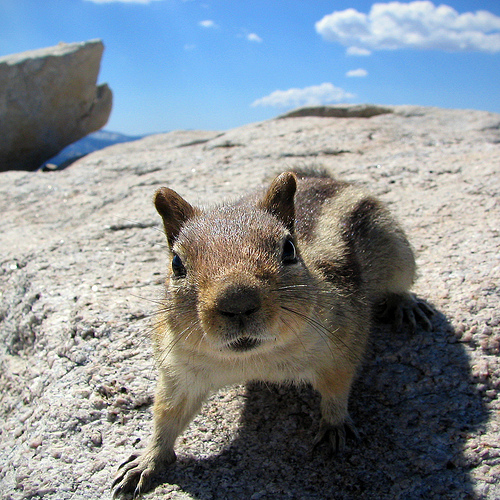Several years ago, on a soggy but majestic mountain afternoon, I hiked into the Yosemite backcountry to meet UC-Berkeley mammalogist Jim Patton. Patton and his colleagues at the Museum of Vertebrate Zoology were retracing the steps of renowned naturalist Joseph Grinnell, who surveyed California’s wildlife early in the last century — and obsessively documented his work in voluminous, barely legible field journals. (Fellow archive nerds, see some wonderful examples here.)
Thanks to Grinnell’s tireless note-taking, Patton and his team were able to repeat the surveys, and get a sense of how Yosemite’s wildlife has changed over the past 90 years. Of the 30 mammal and bird species studied by both Grinnell and the modern-day Berkeley team, 14 show no significant change in their range, but 16 have shifted their habitats, with lower-elevation species consistently expanding their range uphill and higher-elevation species — the pika, the alpine chipmunk — retracting the lower limit of their range. The pattern suggests that many of Yosemite’s critters are already responding to climate change, and habitat models developed by the researchers strengthened this conclusion.
But that’s not the end of Grinnell’s legacy.
 Delving into the deep Museum of Vertebrate Zoology archives, the Berkeley team sampled skin from the actual alpine chipmunks Grinnell trapped in Yosemite nearly a century ago, had the samples analyzed at a lab specializing in ancient DNA, then compared the results with a similar genetic analysis of the park’s current alpine chipmunks (While Grinnell and other naturalists of his time didn’t hesitate to kill critters in the name of science, today’s researchers are more restrained: The modern samples came from probably unpleasant but non-lethal chipmunk ear punches.) In a study published yesterday in Nature Climate Change, Emily Rubidge and her co-authors report a decline in overall genetic diversity within Yosemite’s shrinking population of alpine chipmunks, as compared with another Yosemite chipmunk species that has stayed put since Grinnell’s time. The analyses also suggest that as the alpine chipmunks’ range retracts uphill, their once-free-flowing population is becoming isolated into small subpopulations.
Delving into the deep Museum of Vertebrate Zoology archives, the Berkeley team sampled skin from the actual alpine chipmunks Grinnell trapped in Yosemite nearly a century ago, had the samples analyzed at a lab specializing in ancient DNA, then compared the results with a similar genetic analysis of the park’s current alpine chipmunks (While Grinnell and other naturalists of his time didn’t hesitate to kill critters in the name of science, today’s researchers are more restrained: The modern samples came from probably unpleasant but non-lethal chipmunk ear punches.) In a study published yesterday in Nature Climate Change, Emily Rubidge and her co-authors report a decline in overall genetic diversity within Yosemite’s shrinking population of alpine chipmunks, as compared with another Yosemite chipmunk species that has stayed put since Grinnell’s time. The analyses also suggest that as the alpine chipmunks’ range retracts uphill, their once-free-flowing population is becoming isolated into small subpopulations.
For animals whose habitat is soured by climate change, there are two options. Well, three. They can move to a more tolerable climate. They can adapt — genetically or behaviorally — to the new conditions. Or they can go extinct. For species like the pika and the alpine chipmunk, which already live on islands of habitat above treeline, the first option is literally a dead-end strategy. Can they take the second, and evolve their way out of a bad situation?
I recently edited a fascinating High Country News story by my friend Hillary Rosner, which describes how the rate of coat-color change in snowshoe hares may be responding to changing snowfall levels. Luckily for the hares — and for the Canada lynx that dine on them — snowshoe hares are still plentiful and diverse, making small, relatively fast evolutionary adjustments more likely. For species like the alpine chipmunk, survival means not only outrunning the heat in the short term, but also slipping through a narrowing genetic bottleneck.
Some species will survive the squeeze; some won’t. But what’s certain is that Yosemite, down to its smallest mammals, is no longer the place Joseph Grinnell once knew so well.
Fierce Yosemite chipmunk photo from Flickr user Jeff Pang.
Joseph Grinnell photo courtesy of the UC-Berkeley MVZ.

Tiny chipmunk is so cute I want to die. GET IN MAH POCKET TINY CHIPMUNK
Joseph Grinnell, less so. With respect, but I can smell that room from here.
Grinnell was a great man, but a hot date he was not. (Unless tiny dead animals are your thing, I suppose.)